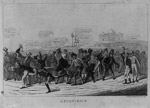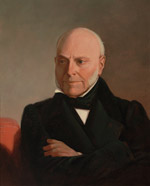Splendid Hall
John Quincy Adams
No single individual is more closely identified with the old House Chamber than John Quincy Adams. In this room, in 1825, Adams was elected and inaugurated the sixth President of the United States. In 1831, Adams returned to this Chamber as a newly-elected Member from Massachusetts, holding his seat until his death, 17 years later. He remains the only former President to serve in Congress.
The 1824 Presidential Election
A Foot-Race (1824) by David Claypoole Johnston addresses the hotly contested Presidential election of 1824, in which no candidate received the majority of the Electoral College vote. The Constitution makes provision for such an event. The House of Representatives must choose the President from the top three candidates, each state having one vote. The candidates in 1824 were all men of national reputation and experience. William Crawford of Georgia, Secretary of the Treasury, was the choice of the Congressional Caucus and considered the front runner; John Quincy Adams of Massachusetts, Secretary of State, had served in the U.S. Senate and as a diplomat; Andrew Jackson of Tennessee, hero of the battle of New Orleans in 1815 and a U.S. Senator, had won the popular vote in the election; and Henry Clay of Kentucky was Speaker of the House.
The galleries of the old House Chamber were crowded with spectators when both Houses convened there on February 9, 1825, to count the Electoral College vote. Since there was no winner, the state delegations of the House then cast secret ballots. Adams won 13 of the 24 states on the first ballot.
John Quincy Adams in the U.S. House
Adams’ retirement after Andrew Jackson defeated him in the 1828 presidential election was short-lived. Local politicians persuaded him to run for the House in 1830. After winning, he wrote in his diary, .” My election as President of the United States was not half so gratifying to my inmost soul. No election or appointment conferred upon me ever gave me so much pleasure.” An active, often controversial Member, he became known as “Old Man Eloquent.”
John Quincy Adams suffered a fatal stoke during a House debate on February 21, 1848, and died two days later in the Speaker’s Room adjacent to Statuary Hall. His funeral, held here on February 26, 1848, was an occasion of national mourning.

A Foot-Race, David Johnston Claypoole, 1824, etching on wove paper Library of Congress

John Quincy Adams, Ed Alstrom, 2003 (after Jean-Baptiste-Adolphe Gibert, 1844) Oil on canvas Collection of the U.S. House of Representatives

Detail of tally sheet, Electoral Votes, 1825Records of the U.S. House of Representatives, National Archives and Records Administration

Order of the Procession for the Funeral of John Quincy Adams, February 24, 1848Courtesy of the Architect of the Capitol, Gift of the U.S. Capitol Historical Society


